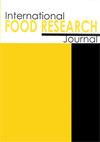Antioxidants and in vitro starch digestibility of coloured rice, and its effect on blood sugar and malonaldehyde in streptozotocin-nicotinamide-induced diabetic rats
IF 1
4区 农林科学
Q4 FOOD SCIENCE & TECHNOLOGY
引用次数: 0
Abstract
Diabetes mellitus (DM) is an autoimmune disease caused by abnormal regulation of blood sugar, with type 2 DM representing 90 - 95% of total DM incidence. One of the preventive measures to improve blood sugar control is the regulation of eating patterns. The purposes of the present work were therefore (1) to determine the proximate composition, carotene and anthocyanin contents, starch digestibility, and antioxidant capacity of Baturraden white rice, Baturraden organic brown rice, and Sirampog black rice; and (2) to determine the effect of feeding these rice on fasting blood sugar and malondialdehyde (MDA) production in diabetic rats. Sirampog black rice had higher levels of carotene and anthocyanin, and higher radical scavenging activity than Baturraden organic brown and white rice. In diabetic rats, Sirampog black rice (Δ = 153.80 mg/dL) could reduce fasting blood sugar more effectively than Baturraden organic brown rice (Δ = 124.48 mg/dL) and Baturraden white rice (Δ = 14.62 mg/dL). Diabetic rats treated with Sirampog black rice also presented the lowest MDA levels of 2.62 nmol/mL when compared with that of Baturraden organic brown rice (3.96 nmol/mL) and Baturraden white rice (10.14 nmol/mL). Based on these results, patients with DM are advised to consume Sirampog black rice. In the future, it is necessary to perform trials in patients with DM to determine the effect of Sirampog black rice on fasting blood sugar and diabetic weight loss.彩米抗氧化剂、淀粉体外消化率及其对链脲佐菌素-烟酰胺诱导糖尿病大鼠血糖和丙二醛的影响
糖尿病(DM)是一种由血糖调节异常引起的自身免疫性疾病,2型糖尿病占糖尿病总发病率的90 - 95%。改善血糖控制的预防措施之一是调节饮食习惯。因此,本研究的目的是:(1)测定Baturraden白米、Baturraden有机糙米和Sirampog黑米的近似组成、胡萝卜素和花青素含量、淀粉消化率和抗氧化能力;(2)测定饲喂这些大米对糖尿病大鼠空腹血糖和丙二醛(MDA)产生的影响。Sirampog黑米比Baturraden有机糙米和白米具有更高的胡萝卜素和花青素含量,以及更高的自由基清除活性。在糖尿病大鼠中,Sirampog黑米(Δ = 153.80 mg/dL)降低空腹血糖的效果优于Baturraden有机糙米(Δ = 124.48 mg/dL)和Baturraden白米(Δ = 14.62 mg/dL)。与Baturraden有机糙米(3.96 nmol/mL)和Baturraden白米(10.14 nmol/mL)相比,Sirampog黑米处理的糖尿病大鼠MDA含量最低,为2.62 nmol/mL。基于这些结果,DM患者建议食用Sirampog黑米。未来,有必要在糖尿病患者中进行试验,以确定Sirampog黑米对空腹血糖和糖尿病减肥的影响。
本文章由计算机程序翻译,如有差异,请以英文原文为准。
求助全文
约1分钟内获得全文
求助全文
来源期刊

international food research journal
Agricultural and Biological Sciences-Food Science
CiteScore
1.40
自引率
0.00%
发文量
75
期刊介绍:
The International Food Research Journal (IFRJ) publishes papers in English, six (6) issues a year with the coverage of:
Food Science and Technology
Nutrition and Dietetics
Agriculture, multidisciplinary
Chemistry, multidisciplinary
The scope of the Journal includes:
Food Science, Food Technology and Food Biotechnology
Product Development and Sensory Evaluation
Food Habits, Nutrition, and Health
Food Safety and Quality
Food Chemistry, Food Microbiology, Food Analysis and Testing
Food Engineering
Food Packaging
Food Waste Management
Food Entrepreneur
Food Regulatory
Post-Harvest Food Management
Food Supply Chain Management
Halal Food and Management
 求助内容:
求助内容: 应助结果提醒方式:
应助结果提醒方式:


